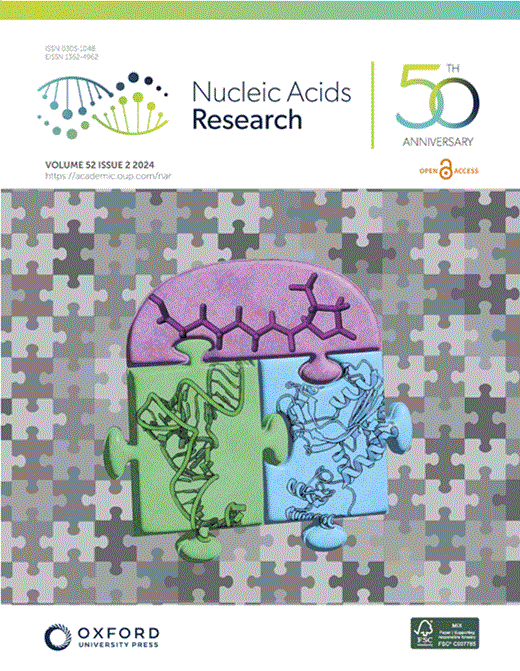F质粒分配蛋白ParA的突变分析揭示了寡聚化和质粒维持所需的残基
IF 16.6
2区 生物学
Q1 BIOCHEMISTRY & MOLECULAR BIOLOGY
引用次数: 0
摘要
质粒等可移动的遗传因子在抗菌素耐药性的出现中起着至关重要的作用。因此,质粒维持蛋白如Walker a型atp酶/ParA超家族中的ParA是新型抗生素的潜在靶点。ParA的质粒分配依赖于atp依赖的二聚化和细菌类核上ParA- atp的化学电泳梯度的形成。尽管ParA的聚合在许多情况下已被报道,但在质粒维持中聚合的必要性仍不清楚。在这项研究中,我们提供了对ParA的聚合和聚合对质粒维持的影响的见解。我们报道了来自F质粒(ParAF)的ParA中的两个突变,Q351H和W362E,它们独立于ParBSF分配复合体形成细胞质丝。这两种变体都不能分割质粒,不能结合非特异性DNA,并作为超阻遏物抑制ParAF启动子的转录。此外,我们证明了ParAF的聚合需要atp依赖的构象开关。我们在预测的ParAF纤维结构的界面上发现了两个残基,第12螺旋上的R320和第14螺旋上的E375,它们的突变破坏了ParAF W362E的纤维组装并影响了质粒的分配。因此,我们的研究结果表明,ParAF的c端螺旋在质粒维持和组装成高阶结构中起作用。本文章由计算机程序翻译,如有差异,请以英文原文为准。
Mutational analysis of the F plasmid partitioning protein ParA reveals residues required for oligomerization and plasmid maintenance
Mobile genetic elements such as plasmids play a crucial role in the emergence of antimicrobial resistance. Hence, plasmid maintenance proteins such as ParA of the Walker A-type ATPases/ParA superfamily are potential targets for novel antibiotics. Plasmid partitioning by ParA relies on ATP-dependent dimerization and formation of chemophoretic gradients of ParA-ATP on bacterial nucleoids. Though polymerization of ParA has been reported in many instances, the need for polymerization in plasmid maintenance remains unclear. In this study, we provide insights into the polymerization of ParA and the effect of polymerization on plasmid maintenance. We report two mutations, Q351H and W362E, in ParA from the F plasmid (ParAF) that form cytoplasmic filaments independent of the ParBSF partitioning complex. Both variants fail to partition plasmids, do not bind non-specific DNA, and act as super-repressors to suppress transcription from the ParAF promoter. Further, we show that the polymerization of ParAF requires an ATP-dependent conformational switch. We identify two residues, R320 in helix 12 and E375 in helix 14 at the interface of the predicted ParAF filament structure, whose mutations abolish filament assembly of ParAF W362E and affect plasmid partitioning. Our results thus suggest a role for the C-terminal helix of ParAF in plasmid maintenance and assembly into higher order structures.
求助全文
通过发布文献求助,成功后即可免费获取论文全文。
去求助
来源期刊

Nucleic Acids Research
生物-生化与分子生物学
CiteScore
27.10
自引率
4.70%
发文量
1057
审稿时长
2 months
期刊介绍:
Nucleic Acids Research (NAR) is a scientific journal that publishes research on various aspects of nucleic acids and proteins involved in nucleic acid metabolism and interactions. It covers areas such as chemistry and synthetic biology, computational biology, gene regulation, chromatin and epigenetics, genome integrity, repair and replication, genomics, molecular biology, nucleic acid enzymes, RNA, and structural biology. The journal also includes a Survey and Summary section for brief reviews. Additionally, each year, the first issue is dedicated to biological databases, and an issue in July focuses on web-based software resources for the biological community. Nucleic Acids Research is indexed by several services including Abstracts on Hygiene and Communicable Diseases, Animal Breeding Abstracts, Agricultural Engineering Abstracts, Agbiotech News and Information, BIOSIS Previews, CAB Abstracts, and EMBASE.
 求助内容:
求助内容: 应助结果提醒方式:
应助结果提醒方式:


